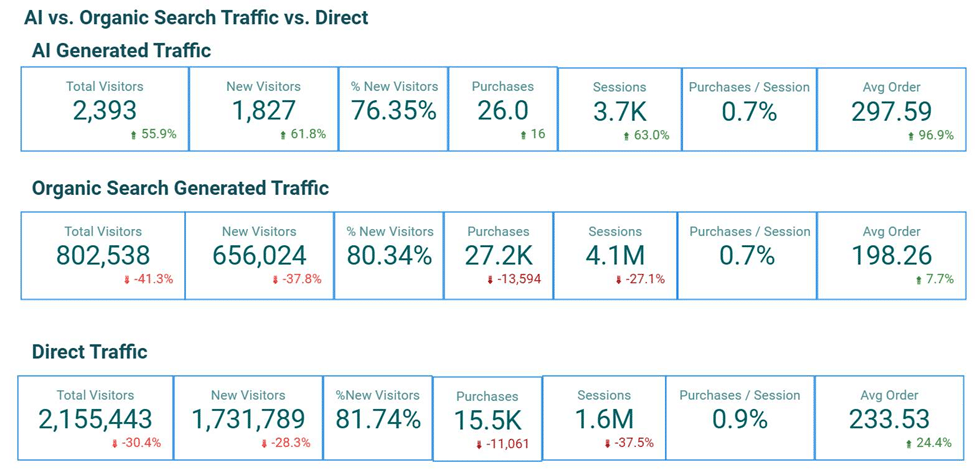
AI is changing how people search, find and engage with content online, which means it’s changing how traffic reaches your website. If you’ve noticed a dip in organic search traffic or a rise in unexplained direct visits, AI tools like ChatGPT, Gemini and Perplexity may play a more significant role than you think.
AI tools are disrupting traditional web traffic
Not a day goes by without something about AI popping up — whether on the news, in an online article or your inbox. Some people fully embrace it, others are wary, and many are still unsure what to think.
From my clients’ perspectives, I often hear one question: “What impact is AI going to have on my website?” But the more relevant question might be: “What has AI already done to your traffic?” The usual response? Crickets.
AI’s effect on website traffic is similar to what we saw when Google rolled out featured snippets. When users get a complete answer directly from an AI tool, they often stop searching — AI effectively intercepts that traffic. But if the AI response cites your website (or, on occasion, includes a direct link), there’s a chance users will click through, creating AI-driven traffic. In other cases, the AI might mention your brand, prompting users to search for it directly or try entering your URL.
The result? A drop in search-generated traffic can make it seem like your SEO efforts have taken a hit. However, some of that lost organic traffic may be categorized differently in your analytics. The challenge with measuring AI-driven traffic is that many AI tools, particularly mobile apps, don’t send HTTP header information to websites. Without this header data, referral information is lost, and AI-driven visits often appear as direct traffic.
In some cases, AI tools do send header information. Still, if your analytics tool doesn’t categorize them correctly (for example, if you haven’t set up a custom AI channel, as most analytics tools don’t do this by default), the traffic might be recorded as referred traffic or end up in vague categories like “other” or “unassigned.”
Dig deeper: ChatGPT growing as a traffic referrer, reshaping search behavior, report says
Different AI platforms handle referral data differently, which adds complexity to traffic analysis. The table below outlines when and how a few AI tools transmit header information if a user follows a link to a website. For instance, tools like Azure AI Search, Microsoft Entra application proxy and Postman send HTTP headers, while others — such as ChatGPT or embedded chatbots — might not.
| Channel | Result Type | Referral Included | Channel Assignment |
| ChatGPT | Citation Results | Yes | Source:chatgpt.com Channel: Referral |
| ChatGPT | Search Results | No | Source: Channel: Direct |
| Gemini | N/A | Yes | Source: gemini.google.com Channel: Referral |
| Perplexity | N/A | Yes | Source: perplexity.ai Channel: Referral |
| Claude | N/A | Yes | Source. Claude.ai Channel: Referral |
Some AI platforms, like ChatGPT’s search results, provide no referral data, while others, like Perplexity and Claude, do. If an AI tool is a self-contained mobile app or an embedded chatbot, it’s more likely that no header information will be sent.
To supplement the chart, I ran my own tests using Google’s Gemini on mobile and desktop devices. The results varied from those reported in the chart.
Using different queries, I asked Gemini for information about a company and the URL to the company’s site.
- In one test, the source appeared as Google and the traffic categorized as “organic search.”
- In another, it appeared as direct traffic with no header information (classified as direct).
- In a third, it showed as referral traffic.
Why the difference? It seems to depend on the device.
- When queryied via a mobile browser, the traffic showed as organic search.
- When made on an Android app, it appeared as direct traffic.
- When done on a desktop, it was classified as referral traffic.
Notably, during several repeat tests, most results showed no header information and the traffic was classified as direct.
Should you be concerned about AI stealing your website traffic?
The correct answers are: “Yes and no” or “It depends.”
If your site’s primary goal is content distribution and you rely on ad revenue, then yes, AI could be a concern. You lose ad impressions and revenue when AI answers a potential visitor’s question without directing them to your site. This issue is especially pressing for news outlets, online magazines and similar businesses. It’s also the reason behind the ongoing dispute between Meta and the Canadian government, with Canada introducing revenue-sharing laws to ensure news publishers are compensated when platforms display their content without driving traffic to their websites.
For retailers — whether online or brick-and-mortar — the impact of AI is more nuanced. Let’s say your website supports a chain of ice cream parlors, and an AI assistant helps users find the nearest location with hours and directions when they ask, “Where is the closest place to buy ice cream right now?” In that case, there’s no need to worry. AI has simply become a lead generator for you. However, if your business isn’t appearing in AI-generated recommendations, that problem needs addressing.
For ecommerce retailers, the impact depends on how users search. If someone searches for your product by brand name and AI provides a link to your site, there’s no issue. But if a user searches for “where to buy a fancy blue sweatshirt” and AI doesn’t showcase your site or your product — even though you sell fancy blue sweatshirts — that’s a problem.
Dig deeper: 9 essential tips for building a website that drives conversions
How to adapt to AI’s impact on your website
New tools are emerging to help businesses understand how AI perceives their brands and products. Many of these tools leverage large language models (LLMs) — the same foundation AI platforms use. According to Dixon Jones, the creator of Waikay.io:
- “Understanding what AI knows about your brand compared to your competitors is critical to leveraging AI for your benefit.”
I developed an AI Traffic Dashboard for my clients to demonstrate AI’s impact on website traffic. The charts show that while only a small portion of their traffic is currently driven by AI (which is often mixed into their direct traffic), it is already generating online sales.

Further data reveals that AI is bringing new visitors to the site, who tend to spend more per order than users arriving through organic search. However, this increase in AI-driven traffic hasn’t yet fully offset the decline in organic and direct traffic. Without capturing and analyzing this data in detail, businesses risk falling behind competitors better prepared for the AI-driven digital landscape.

Understanding where AI-generated traffic is coming from geographically can provide valuable insights into the demographics of who is most using AI. With this, you can craft an AI marketing strategy that targets these emerging audiences.

Dig deeper: New content strategies for handling AI-powered search
You can’t afford to ignore this change
Think back to 1994, when the first true web search engines emerged. Companies that embraced search engines as a complement or alternative to the Yellow Pages and implemented SEO strategies surged ahead of those who hesitated. Many who ignored the shift struggled to catch up or disappeared altogether.
Today, AI is driving another major transformation in how users interact with the web, and you can’t afford to ignore its impact on your website’s traffic. Take action now:
- Set up your analytics tool to track AI-driven visits.
- Create a dedicated custom AI channel to avoid misclassification.
- Analyze your AI traffic, focusing on top landing pages.
- New vs. returning visitors: Is AI bringing a fresh audience?
- Conversion rates: Is AI bringing buyers or just window shoppers?
- Geographic trends: Where is this traffic coming from?
Why does this help?
AI is already reshaping digital traffic flows. By monitoring and understanding AI-driven visits, you can refine your AI, SEO and marketing strategies to stay ahead of the competition. Regular analysis allows you to adjust your strategies and keep your website competitive in the growing AI-driven digital landscape. Don’t ignore AI — embrace it as an opportunity and leverage it to your advantage.
Dig deeper: How to transform your website into a continuous marketing powerhouse
The post How AI is changing the rules of web traffic appeared first on MarTech.
